At 4:30 pm our gang headed to the Hanoi airport for our flight VN 247 to Hue on the central coast of Vietnam. We arrived in Hue in the evening. Hue is located on left top of the map.
We lodged at the Camellia Hotel. It was not much to look at from the exterior, but the interior was elegant. Dinner tonight was on our own. Since I had eaten so much earlier, as often was the case, a snack bar in my room was sufficient.
Day 8, November 30th Tour Citadel
Visit Minh Tu Orphanage
Although all our breakfasts were very good, we had the best breakfast of the trip on the 11th floor of this hotel. After our breakfast we explored some impressive aspects of Hue. Hue was the imperial capital, built by the first king of the Nguyen Dynasty during a time recognized as the golden age of Vietnam. For centuries, Hue has been a main cultural, religious, and educational center of Vietnam.. We visited the older section of Hue -- a moated, walled citadel surrounded by eleven stone gates
.
We toured the citadel. the Imperial Enclosure, and saw its inner Forbidden Purple City, a private area reserved for the emperor. The American bombing in 1968 in response to a communist takeover of Huế flattened most of the Imperial city. Only a few buildings survived, such as the Thai Hoa Temple, Can Thanh Temple, The Mieu, and Hieu Lam Cac Reconstruction is still taking place, especially in the Purple City.
Only a short distance away, and also on the Perfume River. was the Thien Mu Pagoda. We had to climb a number of steps to reach it, but the effort was worth it. The Thien Mu Pagoda has its roots in a local legend: an old woman once appeared on the hill and said that a Lord would come and build a Buddhist pagoda for the country's prosperity. Hearing of this, Lord Nguyen. Hoang ordered the construction of the pagoda of the "Heavenly Lady" (Thien Mu).
The octagonal Phuoc Dien Tower (1864) in the front of the complex rises 2m meters high and has seven levels. The seven successive tiers, each of which is dedicated to a human form taken by the Buddha or a step to enlightenment depending on whom you ask).
The higher elevation here gave us a nice overlook of the Perfume River below.
Near the entrance gate are 12 huge wooden sculptures of fearsome temple guardians with real facial hair.
Dai Hung shrine, in the main-hall,building
Near the rear of the complex houses a national relic: the car in which the monk Thich Quang Duc rode from his temple to Saigon on June 11, 1963. He stepped out of the car in an intersection, sat down in the lotus position, and burned himself to death in protest against the regime's violations of religious freedom.
At noon we drove out to the Dong Thuyen Monastery for a vegetarian lunch (eaten in relative silence and closed with a huuuuuum).
Quang presided over the event. To photograph, us and include everyone, he had to back up against the wall.
Young Buddhists nuns served the delicious meal.
After lunch we visited the Minh Tu Orphanage, a project supported by the Grand Circle Foundation. One of the GCT contributions was this generator.
Minh Tu Orphanage was founded by three Buddhist nuns who literally found a baby on their doorstep. Now privately run and locally supported, the facility provides a home for about 191 children and offers care and nurturing to the region’s youth.
We started our “visiting” with the youngest and worked our way to the older children.
The children were delightful and seemed happy that we came.
At 7 pm that evening Quang took us out to the local Phuoc Restaurant for dinner. The waitresses dished out the food at the table. The meal included pancakes, shrimp,chicken, fish baked in clay pot and RICE.
As we departed, I took a parting shot of the restaurant’s entrance. They had served the best meal of the trip!
Day 9, December 1st
Overland to Hoi An
Walking Tour of Ancient Hoi An
& Cooking Class
We rose early for breakfast at our pleasant breakfast room.
Luggage was placed outside the rooms by 7 am.
At 7:30 am we left by bus for the cities of Da Nang and Hoi An. As our bus moved along southward, Quang spotted a couple working in a rice field and summoned the bus driver to stop for photos.
Then just down the road a bit was another photographer's moment.
Another photo stop at a lake allowed us to watch boats used for mining shells. The lake bottom was pumped up through hoses and the mucky water was strained for salable shells.
We continued traveling along on National Hwy 1 and came to Hai Van Pass. This used to be a serious obstacle for travel to Da Nang, but the construction of a tunnel has changed that. The Hai Van Tunnel is Southeast Asia’s longest tunnel and it seemed forever us for to go through it.
We continued on to Da Nang. When we crossed the river that exited to the sea, Quang mentioned that the beach to our left (Mambo Beach) was where the US marines had landed. To the veterans it was known as Red Beach.
Our bus shortly pulled over at a bay and Quang gave us time to explore on our own here in Da Nang. A number of fishing boats dotted the bay.
Further along the beach scrimpers were gleaning out shrimp from their accumulated catch.
Wink gazed over the all-to-familiar setting and mused about the conflict here 40 years ago.
We continued our journey along the China Beach that had been made famous by a TV series of the same name. We did not stop, reserving this site for a later visit.
Off to the right were remaining barracks from US forces during the war.
We made a happy stop at a marble outlet (Xuat Anh Marble) along the highway. In the background beyond this marble statue can be seen Marble Mountain.
This region along China Beach has been turned into a tourist resort. Construction of large hotels was still taking place.
By noon we had reached Hoi An and stopped at a local restaurant called Goda. They served the popular Tiger beer so common throughout Vietnam.
At the Ancient House (really a resort) we weregreeted with a refreshing drink before settling into our rooms where fresh flowers awaited us.
Hoi was an important trading port in the 16th and 17th centuries and is a UNESCO World Heritage site today. A well-known feature in this port town is the Japanese covered bridge with its own temple and statuary. This was our first stop on our city tour.
When we reached the middle of the bridge, Quang pointed out the built in shrine.
On the other side of the bridge we encountered what had been the Japanese side.
Close-up of the lady in the foreground of the last picture.
A light rain had begun to fall but that did not keep us from our appointed tasks. We went into this Phuc Kien Congressional House dedicated to serve the local Chinese community
The age of this old house is approximately a couple of centuries. The old house reflects the combination of both Japanese and Chinese architectural geniuses.
From the Tan Ky House we headed to Champa Restaurant for a cooking demonstration class of local fares.
After the cooking class we ate the newly created dish.
For desert we celebrated the birthday of Maxine and Gloria with cake.
but only after the celebrants blew out the candles.
Then back to our Ancient House Resort which was built in the special style of the towns ancient houses. Housed in natural and beautiful landscape, beautiful flowers added to the beauty.
Day 10, December 2nd
Hoi An/Explore Champa Ruins
& My Son Sanctuary
Optional Countryside Cyclo Tour
and Thu Bon River Cruise
After breakfast, we traveled through the rice fields of the countryside to My Son Sanctuary, Vietnam's most significant Champa kingdom site, which prospered from the 2nd to the 15th centuries.
My Son was established as a religious center in the 4th century in a lush, isolated valley overlooked by Hon Quap (Cat's Tooth mountain). The Champa were Hindus, and in the temple city they built lots of temples. Their architecture reminds us of the Hindu statues from India and also of Angkor Wat in Cambodia.
Part of the visit to My Son was a show with traditional music and dance. This was completely different from the Vietnamese music. Our timing was right for a performance was to begin at 9 am.
We walked around these red brick ruins, having time to admire the delicate masonry.
There was evidence of the American-Vietnam War in the damaged walls and bomb craters caused by US bombing.
Quang showed us a short cut back to the bus. Still it was rather a lengthy walk which reminded us of the heat and humidity of what was really our first hot day.
We returned to Hoi An in time for lunch at the local Morning Glory Restaurant.
I signed up for the optional cyclo-rickshaw ride through a rural area of Hoi An, followed by a Thu Bon River Cruise. We traveled by cyclo-rickshaw to Cam Nam village. I passed my camera over to a fellow to take this photo of us adventurers posed for launch.
After as nice lengthy ride we approached the lovely Thu Bon River.
As I surveyed our boat in the docking area, this bull was giving me the eye.
Always helpful, Sonny assisted us into the craft.
Shortly we came across this ferry boat landing site.
The setting sun added to the beauty of the cruise.
Quang took photos along the way. Later he and his wife would make a CD for us to remember the great times.
Our cruise ended at the riverfront of the old city. Lights from our restaurant shimmered on the water. The meal was included with the tour. We had our first pumpkin soup of the trip.
Day 11 November 3rd
Morning at China Beach
At 6 am we were were roused by our wake-up call to eat an early breakfast, put luggage outside the door and be ready to depart by 8 am. Our trip to the airport in Da Nang took us to the famous China Beach where we again passed the old US buildings from the war.
Our bus parked and we were free to roam China Beach.
For Wink this again brought back memories when he was stationed here 40 years ago. On the bus he volunteered to reflect on his experiences then and his reaction today.
Wink kindly consented to allow me to take photos of his wartime pictures in the service. All of Wink’s recollections were emotional.
He also recalled his reactions to the Mai Lai Massacre conducted by a unit of the US Army on March 16, 1968 of 347–504 unarmed citizens in South Vietnam, all of whom were civilians and a majority of whom were women, children (including babies) and elderly people.
On our visit to China Beach, a lone fisherman cast his net along the shore.
Our OAT group could bask in the sunshine, kick up the sand and pose for photos
Da Nang had developed into a modern and prosperous city.
Quite in contrast to the city photographed by Wink forty years ago.
When we were about to depart Da Nang, I took a shot of the propeller of our turbo jet from my window seat.
The stewardess had us buckle up for takeoff.
Sonny was still with us. He stayed with us the entire trip as an apprentice with Quang (part of an OAT employment requirement). Actually, he was already an experienced guide, but sought a position with
OAT. He demonstrated that he was a good guide when given the opportunity.
I took a parting shot of the countryside as we left the Na Dang airspace.
Day 11 November 3rd
Fly to Nha Trang “A Day in the Life” of basket-weaving village
After visiting China Beach we flew from Danang airport to the beachside town of Nha Trang. Our first activity in Nha Trang was to travel to a basket-weaving village in the Dien Phu District,where we learned about rural life in Vietnam. When we got off the bus we had to work our way through rice paddies to reach the village chief at Xom Glo.
The village chief had “jurisdiction” over 5 hamlets, a considerable region.
This wise man interacted well with our group and explained his responsibilities as chief. We gathered around tables under the trees for a lunch.
We moved into a porch-like area of a home that had a cottage industry of making baskets. Since it had begun to rain we welcomed the shelter.
The workers were very proficient at their tasks.
The rain continued unabated so we huddled under our umbrellas and headed along a muddy and slippery path to the security of our bus. We had muddy shoes, but we survived the rain. Apparently the weatherman did not know that the rainy season had ended.
By 4 pm we arrived at the Angella Hotel.
The lobby featured this beautifully decorated Christmas tree.
From my room I could see the waterfront that we would later visit.
Our group rested up a little before the 6:30 dinner engagement at the Gia Restaurant.
Our friendly waitress served chicken soup, seafood salad, grilled scallop with cheese, stir fry pok choy and caramelized chicken
Day 12, December 4th
Tour Nha Trang
Boat Tour to Fishing Village
& Mini beach
After breakfast on the top floor of our hotel we boarded a ferry boat to take us to a fishing village.
The harbor along the waterfront was crowded with fishing boats.
Villagers drew attention to their wares.
We walked past a school yard, causing excited children to come forward to greet us and extending high fives.
We stopped at a local smelly fish product “factory” where the owner explained his processing method.
Back in our ferry boat, we exited the harbor where so many boats had been tethered.
Our destination was around the island to a beachfront resort area. At the end of the island a few fishermen were casting from a remote spot that jutted into the water.
In the distance we could see the dock of our relaxation haven at Mini Beach.
We stretched out on lined-up lawn chairs until the rain began to fall. We scurried under a thatched covered dinning area.
Because it was almost lunch time, we ordered items from a printed menu. I chose battered fish. The fish was battered but the fish was not like the accustomed flaky cod at home. It was more like a firm fish steak (sailboat) cut into pieces. The price was reasonable.
Others among our tribe ordered hamburgers and french fries. The burgers were whoppers.
The rain continued to fall, dripping water fell from the trees.
This provided some with the opportunity to have their nails painted and decorated by native artists at the resort.
On our return trip to the mainland, I took a photo of the rain clouds with a mountain background.
As we drove to our hotel we stopped for a train. I captured the tail end of the cars after most of the train passed.
That evening there were discussion sessions at the hotel to tackle controversial subjects.
Day 13, December 5th
Overland to Dalat
Tour of Dalat
Home-hosted dinner
After our breakfast buffet we placed our bags outside the rooms and loaded into the bus for travel overland to Dalat. A large Catholic church along the way gave evidence of the French influence here. It was raining and I shot through the window so the photo was less than perfect.
The roads were pockmarked with holes filled with water. The shoulders were nothing but mud. This was a good day for driving in the comfort of a bus.
The continuous rain contributed to overflowing rivers.
When the rain let up we were able to make photo stops. Unfortunately, we never stopped for the many beautiful cascading waterfalls.
When the rain resumed, the road conditions became worse
At our next happy stop, the driver had his bus washed with hose water to clear away the mud.
The bus stop had a pet monkey which encouraged more photo shots.
Moving along we came to more waterfalls, but pictures from a moving bus does not do them justice.
At 1 pm we reached our hotel Dalat Du Parc and checked in.
By 2 pm we were ready to be taken out to the cable cars that were to transport us to Truc Lam Zen Buddhist Pagoda. The cars were designed for 4 people, but since there were just our number, we were placed with only two each.
Below us were the green houses so prevalent in this area. Since the weather may reach in the 40s, the plants were protected. They were also shielded from heavy rains.
And of course the misty rain was evident.
Then at the end of the line, we visited the Pagoda.
A Buddhist monk busied himself around the altar area and occasionally bonged a gong.
Quang drew our attention to the Loafers of Paradise flowers growing nearby.
As 6:30 pm approached we prepared for our home hosted dinner. Our hosts picked us at the hotel
where we divided into two groups. Our host on the right introduced himself at the hotel. Once in the home we were introduced to other members of the household -- ten people, all relatives, shared the same home
After dinner, one of the young ladies took us to their upstairs chapel where gifts had been placed for either many different gods or one comprehensive one. After explaining her beliefs and the all seeing eye on the poster, she passed out incense, lit them and then placed them on the altar where they smoldered. Note: The all-seeing Divine Eye first appeared to Ngo Van Chieu in a vision and is the iconic symbol of Cao Daism and is featured in all Cao Dai temples. The religion has about three million followers.
We met again downstairs in the living room for further discussions. Note the presence of the Christmas tree.
We left around 9 pm for our Hotel Du Parc. Because of its pleasant temperate climate, beauty of its surroundings of lakes, waterfalls, and pine forests,this area became popular with the French after 1912 as a cool retreat from the heat of the plains. Dalat became known as "Le Petit Paris".
Across the street from the hotel was a small Eiffel tower; villas were modeled after regional French architecture.
Day 14, December 6
Optional Dalat Village Life tour
University visit & education discussion
Hill tribe dance performance
Breakfast was held across the street at the Palace. At 8 am the bus was ready for those who signed up for the optional. We first stopped at a market garden to learn about flowers growing in this region. We filed into a large greenhouse.
Greenhouse growing has greatly enhanced the economy of the region. The Our next topic of study was coffee production. So many of the homes in the highlands had yards with coffee beans spread out on the front yards.
We made happy stops here in the coffee fields, giving us the chance to see the beans up close. Not all the beans turn red at the sane time necessitating further picks.
I thought the nearby flowers also deserved a shot.
When we came close to the village of the mountain people, we transferred from the bus to a tractor-like truck. Our local guide pointed out the location of the village. When the uphill grade became great the driver had to shift into a lower gear.
As we came closer to the Montagnard village children began to appear out of nowhere. Here we were in an isolated traditional village of Buon Chuoi (Banana Village) to meet the Chil people, a hill tribe that practices subsistence farming.
These children spoke a different language than Vietnamese and even our guide could not understand them.
Many of the homes had coffee beans laid out in front, but some also had grains.
Which often attracted pot belly pigs who feasted until driven away.
The pot belly pigs appeared to be quite different from Minnesota porkers.
The village people were quite friendly.
We passed a school where some children were out on the grounds.
We wanted to visit the village chief and that entailed a walk down Main Street.
When we reached his house we had to cross over a deep ditch.
The chief and his wife were inside. She was making garments on a loom. Some in our group
purchased her finished products.
The symbols on the wall and on the front of the house would indicate that these people were Catholics. Quang said that was true of most of the villagers.
While we were visiting the chief, children peered through the window.
When we returned to the bus, I looked back to the homeland of those remote mountain people.
had visited silk factories many times so I was not thrilled at the thought seeing another one. But it wasn’t that bad and I even bought a silk tie here (for a low price).
Continuing on down the highway we came across school girls in uniforms.
The next stop surprised me -- a cricket farm with a snack bar.
Crickets were raised from the earliest stages and placed on paper strips to give them room to roam. When they were large enough for consumption ...
...they were placed on a plate with tomatoes for gourmet snacks.
Quang showed us how to do eat them properly
Other interesting (but not as exciting) sites included rushing water along the road.
And passing a pig truck.
And hillside scenery.
Of course, we over-ate at lunch again. Shown here was BBQ pork Russian style and chicken with ginger.
Back in Dalat, Quang had us dropped off at the central market so we could experience the market place.
We had a little free time at the hotel so I walked over towards Notre Dame Cathedral. Two young girls were sketching the structure and consented to being photographed.
Then at 3:15 pm our driver took us over to the University of Dalat where a school representative explained things about his university.
Following his presentation, each of us was assigned a university student to guide us around the campus and to practice English. My student, pictured here, was a freshman.
Wink, no doubt, had a lively conversation with his assignee.
Maxine not only won over her assignee, but the whole campus family as well.
The day was not over. At 5 pm we were scheduled to visit Lat Village to enjoy their traditional dancing performance. These people had been pushed out by he French and were once very poor; but recently they have prospered from the economy.
The lights were turned off for the performance and they danced around a bonfire - not exactly ideal lighting for the photographer. However the dancing was spirited and the performers allowed for
audience participation
Dinner at Viet Ngoc Duy was quite different tonight. First we had Vietnamese Soup whereby
fresh vegetables were dumped into a water pot at the table and prepared there.
At the close of the meal we had banana flambeau that almost set the kitchen on fire.
GO ON TO 2010 VIETNAM PART III SOUTH: SIAGON
GO ON TO 2010 VIETNAM PART III SOUTH: SAIGON AND MEKONG DELTA





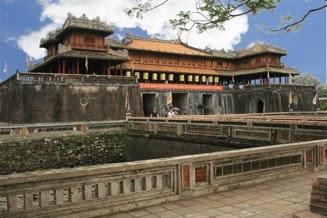


































































































































































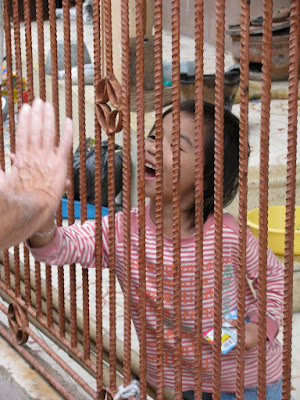















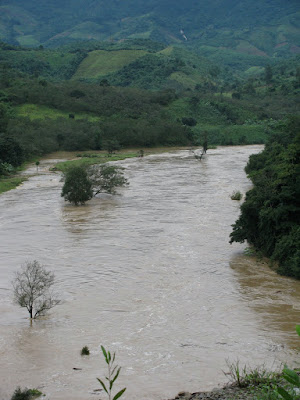





















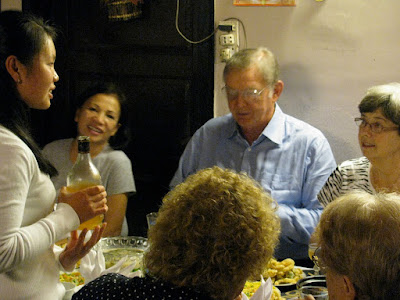













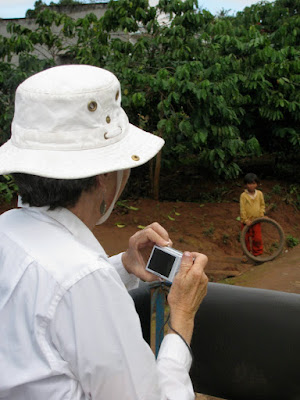






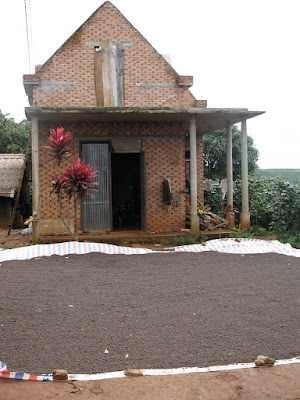

























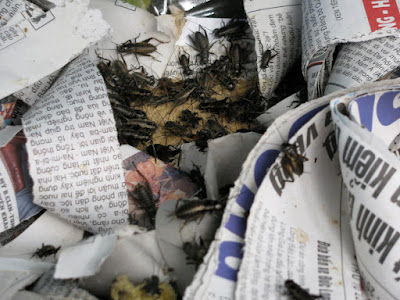































No comments:
Post a Comment